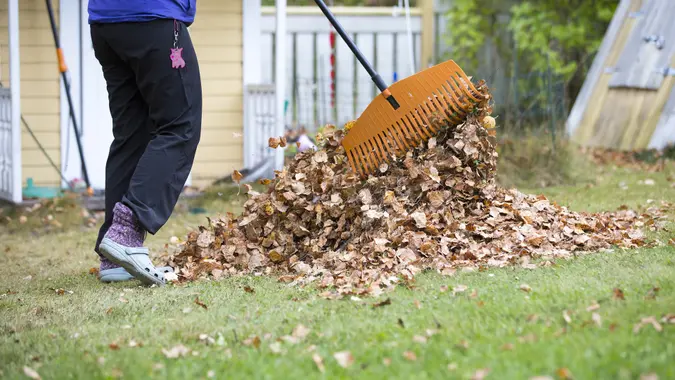The Shrinking Middle Class in 2026: 7 Money Moves To Stay There

Commitment to Our Readers
GOBankingRates' editorial team is committed to bringing you unbiased reviews and information. We use data-driven methodologies to evaluate financial products and services - our reviews and ratings are not influenced by advertisers. You can read more about our editorial guidelines and our products and services review methodology.

20 Years
Helping You Live Richer

Reviewed
by Experts

Trusted by
Millions of Readers
Once, the middle class was synonymous with financial security. The average American household earned enough for basics plus a home, a car and vacations as well as savings for retirement and kids’ education.
However, the middle class has been shrinking for decades. In 1971, 61% of Americans were considered middle class, but by 2023, that figure was only 51%, according to the Pew Research Foundation. GOBankingRates’ research shows it takes a higher and higher income to keep a toehold in the middle class, and the economic challenges of 2026 could strain these Americans’ finances even more.
Finance experts offered some money moves to make to keep from falling out of the middle class.
Why the Middle Class Is Shrinking
Elliot Schwartz, finance expert and CEO of Becca’s, a credit building company, offered some reasons why the middle class keeps shrinking:
- Wage stagnation: Wages aren’t going up as fast as inflation. “During the pandemic and even years after, inflation hit all-time highs and wages never had a chance to get caught up to it,” he said. Corporations focus more on profit margins and earnings per share than on increasing wages relative to the cost of living.
- Tough housing market: The housing market stresses the middle class. “For those trying to buy a home … it is unaffordable,” he said. And rent prices have skyrocketed, too, forcing middle-class people to spend too much of their income on rent and struggle to save for a down payment on a home.
- Debt burdens: Debt is also shrinking the middle class, Schwartz said. For the reasons above, many people in the middle class are building up large credit card debt due to the increased cost of living and are stuck in a viscous cycle of high interest debt.
How To Keep Your Middle-Class Status
Here are some tips on how to avoid falling out of the middle class as it’s shrinking.
1. Get Out of Debt
One of the best ways to hang onto your middle-class status is to pay off your debt as quickly as you can, Schwartz said, particularly high-interest debt. “This should be priority one. Once this is done you should look to save as much as you can until you have six months’ worth of living expenses saved up.”
2. Build That Emergency Fund
Many U.S. households are “one flat tire away from financial ruin,” according to Michelle White, national mortgage expert at The CE Shop. Any emergency spending such as a flat tire, other car repair, emergency room visit, toothache or even funeral expense can put a household into a dire financial position, she warned.
“Using funds from rent or a mortgage payment to fix a flat tire can cause a domino effect,” she added. Having an emergency fund of cash is better than having available funds on a credit card, she pointed out. “The cash doesn’t charge interest and maxing out a credit card can lower your credit score,” White said.
3. Adopt These Good Habits
It is also important to spend less than you are making, Schwartz noted. “If the cost of living is exceeding your budget and you are pulling funds from your emergency fund, then you need to reconsider your budget.”
Simple culprits include streaming services, entertainment and travel expenses. You might need to cut back on or eliminate these to ensure that you are not tapping into your emergency funds, he urged.
4. Don’t Panic, Get Real
There are many great habits to adopt if you want to maintain stability, White pointed out. “First, don’t panic. Get real about your spending habits and have honest conversations about money with your partner if you have one. Figure out where you can trim down your spending and then stick to it,” she said.
She also noted that there are many adult education classes teaching “budgeting, how to spend the least and get the most, how much savings you should have and how to achieve it.” She also recommended a first-time homebuyer’s class, even if you already own a home. “It covers everything from budgeting to saving, goal setting, fixing or improving your credit.”
5. Pay Attention to Tax Policies
Keep in mind that tax laws change frequently, especially with presidential administrations. Therefore, keep abreast of changes that affect your finances and tax brackets, White urged. “There are many opportunities to meet with trained tax professionals often free of charge. Check out the nonprofits in your area to see if any are offering free tax clinics.”
Don’t forget to check in with your human resources department when you have life events, promotions or raises. “You may need to update your state and federal tax withholding, so you don’t come up short on your tax returns.”
6. Avoid Lifestyle Creep and Comparison
Try to keep your emotions in check when it comes to comparing yourself to your friends, family and neighbors to avoid lifestyle creep. “Frustration, anger, jealousy and other emotions can cause all reasonable thoughts to fly out the window. So, what if your neighbor took a vacation. It doesn’t matter if your coworker went to that fancy restaurant for their anniversary. Don’t spend emotionally,” she urged. Make your financial decisions from a calm and measured place.
7. Think Like Forest Creatures
Lastly, she urged, “Think like forest creatures. Squirrel away for a rainy day. Like our friendly neighborhood raccoon, utilize available resources creatively. Take a lesson from the birds. Once you have an egg in your nest, sit on it.”
More From GOBankingRates
 Written by
Written by  Edited by
Edited by 

























